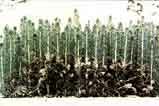Rosellinia Blight
(The other articles like the one below are available at best-writing-service.com)
Rosellinia minor has recently been identified on container-grown seedlings in British Columbia. Previous reports of R. herpotrichioides on bareroot Douglas-fir in the province are now attributed to R. minor. The moist, mild falls and winters of coastal British Columbia are ideal for Rosellinia.
Hosts and damage
Locally, R. minor has occurred on 1+0 container-grown Douglas-fir and Engelmann spruce and 2+0 bareroot Douglas-fir. It also affects bareroot Douglas-fir and Sitka spruce in California and Washington, respectively. Damage occurs in the center of densely sown seedbeds, container-nursery benches, or individual containers where prolonged high humidity, free water on stems and needles, and dense foliage favor the disease (Figure 32). The fungus forms dense mats of whitish brown mycelium (Figure 33) on the lowermost stems and needles of seedling shoots, sometimes binding them together.
Superficially, Rosellinia can resemble the gray mould, Botrytis cinerea, which thrives under similar conditions, and sometimes the two occur together. The two fungi differ in that R. minor forms sexual fruiting structures (perithecia). Rosellinia also has the tendency to grow upward and cover the shoot. Needles beneath the mycelium become chlorotic, die, and are cast, resulting in the seedlings being culled. Few seedlings die. Defoliation can reach 80% on heavily attacked seedlings. After needle death, the mycelium loses its mould-like appearance and becomes flattened against twigs and needles, exposing the small black, perithecia (Figure 34).
Life history*
The life history of Rosellinia is unknown. Infection may result from air-borne conidiospores, mycelium from contaminated soil, ascospores, or all three. Generally, perithecia produce ascospores after the decayed host material is subjected to winter temperatures. Conidiospores are produced during summer. Under favorable growing conditions this may vary, with ascospores produced and released to start new infection centers the same growing season, while mild winters may result in conidiospore production.
* Because little is known about the life history of R. minor, a diagram is not included here.
Management
Cultural practices are important in R. minor management as the fungus requires long periods of high humidity and free moisture. Humidity can be reduced by spacing containers to improve aeration, decreasing irrigation, and increasing ventilation. Growing media should have good drainage to avoid water accumulation. Sanitation is important, so diseased plant material should be removed from the nursery. In bareroot nurseries, bare fallowing during summer will expose the pathogen to the sun's heat and desiccation.
Selected References
Francis, S.M. 1986. Needle blights of conifers. Trans. Brit. Mycol. Soc. 87: 397-400.
Heald, F.D. 1933. Manual of plant diseases. McGraw-Hill, New York, N.Y.
Hepting, G.H. and R.W. Davidson. 1937. A leaf and twig disease of hemlock caused by a new species of Rosellinia. Phytopathology 27: 305-310.
Salisbury, P.J. 1955. Rosellinia herpotrichioides Hepting and Davidson on Douglas-fir seedlings in British Columbia. Interim Rep., For. Biol. Lab., Victoria, B.C.
Salisbury, P.J. and J.R. Long. 1956. A new needle-blight of Douglas-fir seedlings caused by Rosellinia herpotrichioides Hepting and Davidson. Proc. Can. Phytopath. Soc. 23: 19.
Look Alikes
|
Other Fungi |
Insects |
Environmental |
|---|---|---|
|
Gray mould |
|
Overcrowding |
Summary
Rosellinia Blight
|
Principal, locally grown hosts |
Host age and season when damage appears |
|
Nursery type and location |
|
|
|
|---|---|---|---|---|---|---|
|
Bareroot |
Container |
|||||
|
Age |
Season |
Coastal |
Interior |
Coastal |
Interior |
|
|
Douglas-fir, all spruces |
1+0 |
Summer through fall |
Yes |
No |
Yes |
No |
Figures
Click on any image to see the full size version. Press "Back" on your browser to return to this screen.
 Figure 32. Rosellinia on container-grown spruce.
Figure 32. Rosellinia on container-grown spruce.
Figure 33. Container-grown spruce showing the dense mat of Rosellinia mycelium.
Figure 34. Perithecia of Rosellinia.